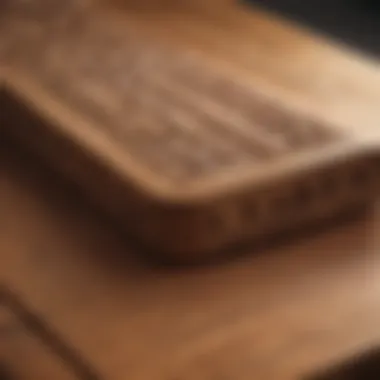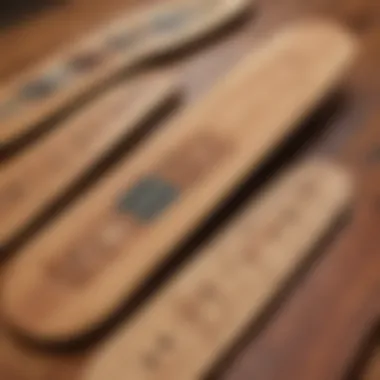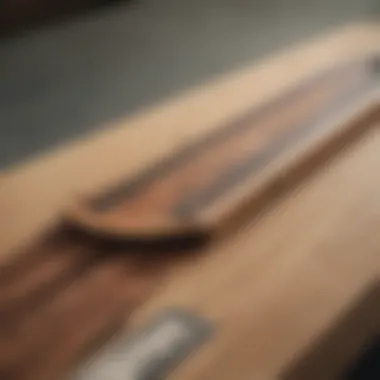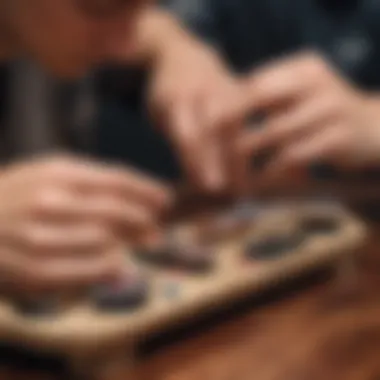Exploring Wood Fingerboard Decks in Skateboarding Culture


Intro
In the vast landscape of skateboarding culture, wood fingerboard decks carve out a niche that is often overlooked yet deeply interwoven with the larger scene. These miniature replicas of traditional skateboards offer a unique avenue for expression, creativity, and community bonding. More than just toys, they represent an art form where craftsmanship and passion collide.
This exploration sets the stage to investigate the significance of wood fingerboard decks, highlighting key elements such as craftsmanship techniques, the evolution of design, and the materials that define performance. Through a balanced look at both novice and seasoned fingerboarders, we'll uncover the skills development potential and the vibrancy of the fingerboarding community. So get ready to delve into a world that marries artistry and athleticism in a way that's distinctly rich in history and culture.
Skills Development
The journey toward mastery in fingerboarding takes practice, patience, and plenty of passion. This section will dissect both the fundamental tricks and advanced maneuvers, providing a roadmap for individuals looking to sharpen their skills.
Basic Tricks and Techniques
Starting with the basics, it’s essential for newcomers to grasp foundational tricks that build confidence and serve as the building blocks for more complex moves. Below are some foundational skills worth practicing:
- Ollie: This fundamental trick involves popping the fingerboard off the ground using a flick of the fingers.
- Kickflip: After mastering the ollie, the kickflip adds a rotation by using the side of a finger to flick the board’s edge.
- 540 Tricks: A slightly more complex maneuver that involves rotation in mid-air, combining balance and timing.
Mastering these basic techniques lays the groundwork for a more impressive repertoire. It’s somewhat akin to learning to walk before you can run.
Advanced Maneuvers and Tips
Once the basics are nest in your grip, advancing to more tricky maneuvers can be quite rewarding. It’s here where creativity shines through. When delving into advanced moves, consider the following:
- Grinds and Slides: Techniques that showcase board control and precision. Different ledges and rails provide various opportunities for experimentation.
- Variations: Make basic tricks unique by adding spins or flips; constantly innovate on what’s already mastered.
- Fingerboard Parks: Create or visit dedicated parks that mimic actual skate spots. This can significantly enhance your game by allowing for practical application of skills.
By blending consistency with creativity, fingerboarding evolves from simple practice into a captivating performance art, showcasing both dexterity and flair.
"Even the greatest of skaters started out with a single kickflip."
With the right foundation in place, it's time to explore gear and equipment to further refine your experience.
Gear and Equipment Reviews
The right gear can elevate your fingerboarding experience from ordinary to extraordinary. Here we’ll take a closer look at the essential equipment and accessories that can influence performance and enjoyment.
Skateboards and Accessories
Your deck is your canvas, and choosing the right one is pivotal. A few factors to consider include:
- Material: Most fingerboard decks are made from layers of wood similar to skateboard decks. Look for options like maple for durability.
- Size and Shape: Depending on personal preference, wider decks offer stability, while thinner ones allow quick flips.
- Wheels and Trucks: These components affect the overall feel of the board. Experiment with different hardness to see what suits your style.
Safety Gear and Recommendations
While fingerboarding is less risky than traditional skating, taking a few precautions can help avoid minor injuries, especially for beginners.
- Finger Guards: These can prevent finger injuries during falls.
- Grip Tape: Ensure your deck has a quality grip tape to hold your fingers in place.
- Quality Flooring: Fingerboarding on smooth surfaces prevents abrasions on your board while enhancing performance.
In essence, gear selection greatly influences not only your skill development but also your overall enjoyment of the sport.
Closure
As we wrap up this exploration, it’s clear that wood fingerboard decks are more than mere accessories in skate culture. They embody the spirit of creativity and community that the sport represents. From the basic tricks that inspire novice skaters to the elaborate designs crafted by skilled artisans, fingerboarding fosters an inclusive environment that welcomes all who share a passion for skateboarding, albeit on a smaller scale. Whether you’re a newcomer or an expert, understanding the craftsmanship and community around fingerboards can greatly enhance your journey in the skating world.
Intro to Wood Fingerboard Decks
The rise of wood fingerboard decks has turned a niche interest into a vital thread within the fabric of skateboarding culture. These miniaturized skateboards not only serve as a transition for young skaters hesitant to hit the concrete but also as a unique form of artistic expression and craftsmanship. Fingerboarding isn't just about tricks; it's about creativity, community, and culture. Through this exploration, we will unearth the layers that make fingerboarding a revered aspect in the skate scene, examining the beautiful intricacies of woodworking and design as well as the place these decks hold in contemporary skate life.
Definition and Use in Skateboarding
Wood fingerboard decks are scaled-down replicas of traditional skateboards, typically crafted from several layers of wood, most commonly maple or birch. These decks allow users to perform tricks using their fingers, just as one would with their feet on a full-size skateboard. For many, this serves as an introduction to the world of skateboarding. You flick, pop, and slide the board along surfaces, mimicking real-life skateboarding moves like ollies and kickflips.
But fingerboarding is more than a mere pastime; it can even lead to competitive opportunities. Engaging in fingerboarding can help foster finger dexterity and improve hand-eye coordination. Across social media platforms like Instagram and Reddit, enthusiasts share videos showcasing their skills, rocking the same tricks that resonate through the streets. The community plays a crucial role here, as the exchange of techniques and ideas offers spaces where anyone can jump in, regardless of skill level.
Cultural Significance in Skateboarding
When we dig deeper into the cultural significance of wood fingerboard decks, an interesting picture emerges. They symbolize not only creativity but also inclusion in a subculture that can often seem exclusive. Where skateboarding requires physical mastery and risk-taking, fingerboarding allows the same thrill of creativity without the need for extensive setup or environment. The act of fingerboarding becomes a way to bond; friends can showcase their skills on a school desk or a coffee table, transforming mundane spaces into playgrounds.
Moreover, fingerboarding has influenced larger skateboarding culture, with many professional skaters acknowledging its impact on their journey. It acts as a bridge, connecting generations of skaters, allowing older fans to relive their glory days and introducing the art of skateboarding to newcomers in a manageable way. The convergence of art, sport, and community gives fingerboarding a prominent place in the growing narrative of skate culture.
"Fingerboarding is more than a hobby; it’s where art meets sport, drawing a tight-knit community around shared passions and creativity."


In this exploration, you'll find that understanding wood fingerboard decks opens doors to appreciating not just the craft itself but also the rich tapestry of interactions and experiences that come with it. From the essential materials to the evolution and community significance, the journey through fingerboarding culture constantly redefines itself.
Materials and Construction of Fingerboard Decks
Understanding the materials and construction of fingerboard decks is vital for appreciating their role in the skateboarding culture. The selection of wood, the techniques employed, and the overall craftsmanship can greatly influence performance, aesthetics, and longevity. For both hobbyists and seasoned skaters, knowing these aspects can inform choices that align with personal preferences or specific styles of fingerboarding.
Types of Wood Used
Maple
Maple wood stands out in the fingerboarding arena thanks to its dense structure. This particular wood is often considered the king of fingerboard decks. Its strength contributes to a superior pop, essential for executing tricks smoothly. Maple's natural rigidity offers a notable response when flicked, heightening both stability and control during performance.
Furthermore, the unique grain of maple not only guarantees durability but also allows for beautifully crafted designs. However, it comes at a cost; maple decks tend to be heavier compared to other woods, which some skaters might find restrictive, particularly during complex tricks.
Birch
Birch is an interesting alternative that balances performance with cost-effectiveness. This wood is lighter than maple, making it a favored choice for those who prefer a more agile feel while fingerboarding. Birch decks are less rigid, which can allow for a more forgiving ride, particularly for beginners. The key characteristic of birch is its versatility; it adapts well to various styles, whether street or vert. On the downside, birch may not offer the same longevity, as it can be susceptible to wear and tear more quickly than its maple counterparts.
Bamboo
Bamboo has gained traction in recent years due to its eco-friendly credentials. This material is both lightweight and surprisingly durable, making it perfect for a fingerboard. Bamboo fingerboard decks tend to have a unique flexibility that can add a fun element to riding. It’s an attractive option for those seeking to combine performance with sustainability. The drawback, however, is that bamboo can sometimes lack the snappy response of harder woods like maple, impacting the overall performance during more technical tricks.
Construction Techniques
Layering
The layering technique is a hallmark of quality fingerboard construction. By stacking multiple thin layers of wood, manufacturers can create a deck that balances strength and flexibility. This method also allows for aesthetically pleasing designs, providing a canvas for custom graphics. Layered decks are typically more resilient to impacts, which translates to longer-lasting performance. However, achieving the perfect balance between layers can be tricky; too many layers might make the deck cumbersome for some users.
Pressing
Pressing is a fundamental technique that involves applying heat and pressure to the wood layers to shape the deck. This method facilitates the creation of various concave shapes and profiles, catering to different riding styles and preferences. Pressed decks often provide a consistent feel, which many skaters appreciate. Nonetheless, the quality of pressing can vary between manufacturers, leading to inconsistencies in performance.
Cutting Techniques
The cutting techniques used in shaping fingerboards can vastly affect how a deck looks and feels. Precision cutting ensures that the final product has a defined and sleek look, whilst also playing a role in the deck's performance attributes. However, if cutting is not executed well, it can lead to uneven decks that might cause balance issues. To optimize performance, manufacturers often utilize advanced cutting technologies to maintain high standards in every piece they produce.
"The material and construction choices in fingerboarding are not just about preference. They engage deeply with the user experience, shaping how tricks are executed and how long a deck will last."
Design Considerations for Fingerboard Decks
When it comes to wood fingerboard decks, the design plays a pivotal role in both functionality and artistry. How a deck is shaped and what graphics adorn its surface can have a profound impact on the rider's experience, technique, and even the aesthetic appeal within skateboarding culture. Here, we will delve into the specifics of shape, size, and visual elements, all of which contribute to the overall identity of a fingerboard deck.
Shape and Size Specifications
Width and Length
The dimensions of a fingerboard deck—its width and length—are fundamental elements that influence both performance and feel. A wider deck generally offers more stability, making it an excellent choice for skaters who focus on tricks requiring a solid base. For example, decks that span around 32mm in width are exceptionally popular among many riders because they provide ample space for foot placement, simplifying the execution of complex maneuvers. Conversely, narrower decks can enhance maneuverability, enabling skaters to perform intricate tricks with greater precision.
However, selecting the right dimensions can be subjective. Some riders might find that a longer deck caters to their style by accommodating their footwork, while others may prefer the nimbleness of a shorter option. The key takeaway is that width and length must align with a skater's preferences and intended tricks, creating a personalized and enjoyable ride.
Concave Types
Concavity is another critical aspect of fingerboard design. The concave shape of the deck significantly affects the rider's ability to control the board during tricks. Generally, there are three primary concave styles: low, medium, and high. High concave decks tend to grip the rider’s feet better, allowing for more aggressive tricks while also providing some leverage for flipping the deck in the air. Many skaters lean toward high concave designs for enhanced performance in flip tricks, as the ridged edges can make it easier to catch the board mid-air.
On the other hand, a low concave might suit less experienced skaters or those focusing on stability rather than flipping tricks, as it offers a more comfortable platform to practice balance. Understanding the unique features of each concave type can greatly assist riders in selecting the correct deck that complements their individual style and technique.
Graphics and Aesthetics
Custom Designs
Custom designs allow riders to showcase their personality and style through their fingerboard decks. A unique graphic can transform a simple piece of wood into a personal statement, reflecting the rider's identity. Many skaters opt for custom designs that incorporate their favorite colors, logos, or even intricate artworks, resulting in a one-of-a-kind deck. This personalization enhances the riding experience, giving the skater a connection to their board that goes beyond functionality.
Moreover, custom designs can serve as a canvas for storytelling. Since every graphic can represent different influences or life experiences, it contributes to the overall culture of fingerboarding. Hence, investing time in designing a custom deck can foster a deeper emotional connection to one’s skateboarding journey.
Thematic Graphics
Thematic graphics also hold a vital place in fingerboarding culture. Themes could center around sports, music, or even popular culture, creating a deck that resonates within larger communities. For instance, a fingerboard showcasing classic rock band logos might attract fellow enthusiasts who share that interest. Such graphics can facilitate interaction among skaters, prompting discussions about shared passions and enhancing the social aspect of the sport.
While thematic graphics often attract attention, they can also pose a dilemma for some skaters. A design that becomes overly popular might lose its novelty as many adopt similar themes, diluting individuality. Thus, striking a balance between trendiness and personal taste is crucial, ensuring that the deck represents a unique blend of personal expression while bearing the spirit of the fingerboarding community.
"Choosing the right design elements for a fingerboard deck isn't just about looks; it's about connecting with the culture and the community it represents."


In summary, the design considerations for fingerboard decks encompass more than mere aesthetics. The interplay of shape, size, and personal graphics contributes to a rider's experience, influencing choices throughout the journey of fingerboarding.
Performance Characteristics
Performance characteristics of fingerboard decks play a crucial role in the overall experience of fingerboarding. These elements not only influence how well a skater performs their tricks but also impact the longevity and enjoyment of the activity itself. Striking a balance between stability and maneuverability, while also considering deck weight, is essential for both beginners and seasoned pros. This in-depth understanding enables skaters to make informed choices about their gear and refine their skills more effectively.
Balancing Stability and Maneuverability
When it comes to fingerboarding, stability and maneuverability are often viewed as two sides of the same coin. Stability ensures that the skater can land tricks with precision, while maneuverability allows for creative movement and adaptability in style. A well-designed fingerboard deck strikes an optimum balance of these qualities.
For instance, a wider deck typically offers more stability, allowing skaters to land tricks without wobbling. However, too much width can hinder the rapid movements and spins that characterize fingerboarding. On the other hand, a slimmer deck allows for agility, making it easier to execute flips and slides, but may compromise stability when landing more complex moves. Here's what to think about:
- Width Considerations: Wider decks provide support but can limit quick side-to-side motions. Meanwhile, narrower decks enhance speed but raise the risk of losing balance.
- Concave Shape: The curvature of the deck can greatly impact both stability and control. A deeper concave can help grip the skater's fingers better but can also make transitions more challenging.
- Personal Style: Ultimately, the right balance between these characteristics often comes down to personal preference. Some skaters may prefer a stable platform while others thrive on the nimbleness of a lightweight board.
Impact of Deck Weight on Tricks
The weight of a fingerboard deck can significantly influence how tricks are executed. A heavier deck often provides better momentum, allowing for stronger pop during ollies and flips. However, this added mass can lead to additional effort to maneuver, particularly when performing intricate tricks. Lighter decks, while easier to handle for tricks like finger flips, may not have the same strength in sustaining impact during landings.
To visualize this, consider the following:
- Heavier Decks: These can be beneficial for skaters who prefer a more grounded style, offering more control during landings but requiring more energy for tricks.
- Lighter Decks: Favored by those who prioritize speed and agility, these decks enable complex tricks but may feel shaky, particularly at higher speeds.
- Personal Preference Again: Every skater's technique and comfort level will dictate what weight they consider ideal. Testing different options and styles can lead to a deeper understanding of how these elements interact.
"The choice of deck weight and design is like choosing a partner in a dance—finding the right chemistry is key to executing those moves flawlessly."
By understanding these performance characteristics, skaters not only choose setups that match their style but also adapt their techniques to the nuances of their tools. This knowledge fosters growth, allowing both new players and experienced pros to excel in the captivating craft of fingerboarding.
The Evolution of Fingerboarding
The evolution of fingerboarding is more than just the chronological development of wooden decks; it encapsulates the transformation within a culture that reverberates out far beyond the miniature skate scene. The simple act of skating with one's fingers may seem trivial, but it has fostered a vibrant community, highlighted innovative craftsmanship, and even bridged gaps between various generations of skaters. Understanding this evolution gives enthusiasts insight into how fingerboarding has molded skateboarding culture itself, providing a backdrop against which tricks and designs flourish.
Historical Timeline of Deck Developments
Starting in the late 1970s to early 1980s, what was once a niche toy swiftly caught the attention of skateboarders looking for a fun way to practice their skills off the board. Equipped with small plastic boards and metal wheels, these initial designs hardly resembled today’s fingerboards. As the 1990s rolled around, the first wooden decks hit the market, mainly made from poplar and utilizing graphics that appealed to younger audiences.
By the late 1990s, pro skaters began endorsing specific brands, which propelled fingerboarding into a larger spotlight. The introduction of maple decks in this period served to enhance performance, making tricks more believable while allowing for better stability and control. Fast forward to the early 2000s, when custom designs surged. Brands like Tech Deck expanded the market with limited-edition runs, setting the stage for a new wave of creativity within fingerboarding.
The last decade has introduced modifications like pre-shrunk wheels and varied concave shapes, aimed at improving trick execution. While some riders prefer a flat board for grinds, others lean toward a more pronounced concave that aids flip tricks. Each development signifies not only a response to rider preferences but also an endeavor to push the limits of what fingerboarding can accomplish.
Influence of Technology on Design
Modern technology has played a crucial role in shaping fingerboard decks, resulting in remarkable innovations that create diverse options for enthusiasts. Today, CNC machines allow for precision-cut decks, creating constancy in dimensions that was nearly impossible by hand. This consistency lends to better performance—crucial in a sport where recalibrating muscle memory is the name of the game.
Moreover, advancements in materials led to lighter decks that do not sacrifice durability. Graphene-infused wood, a cutting-edge approach, offers exceptional strength without the weight burden of traditional materials. Skaters have noted how this tech shift allows for effortless maneuverability alongside stability, blending performance and craftsmanship seamlessly.
Social media platforms such as Instagram and TikTok have also played a role in showcasing fingerboarding as an art form, giving riders a new avenue to share their skills and designs. Videos showcasing intricate tricks have turned modest talents into viral sensations, motivating the community to explore vast possibilities, both in trick innovation and artistic expression.
In summary, fingerboarding's evolution represents far more than years passing; it showcases how a culture can adapt and thrive. By understanding the historical timeline of deck developments and the influence of technology, one can appreciate the landscape of fingerboarding today.
This is a testament to the relentless spirit of skaters and the artistry that breathes life into their craft.
Community and Culture Surrounding Fingerboarding
The spirit of fingerboarding extends beyond just the decks and tricks; it thrives in the community that surrounds it. The culture of fingerboarding acts as the bedrock for enthusiasts, fostering connections that go deeper than shared interests. This section delves into the strength of the community, emphasizing its various elements, the benefits it brings, and important considerations when engaging with it.
Online Platforms and Communities
Forums
Forums represent a cornerstone in the online fingerboarding community, providing a space where both beginners and seasoned pros can exchange ideas, tips, and experiences. They are like virtual plazas, bustling with activity where every post is a new encounter. One characteristic that makes forums particularly appealing is the depth of discussions; topics can range from basic grip techniques to complex discussions on deck construction materials.
One standout aspect of forums is their asynchronous nature. Members can post messages and come back later to read replies, unlike chat rooms which require real-time interaction. This allows for thoughtful responses and the sharing of detailed knowledge. However, they can sometimes become echo chambers if particular viewpoints dominate conversations. In general, forums have proven themselves as valuable assets for those interested in all things fingerboarding, as they cultivate a sense of belonging, while enabling learning and sharing.
Social Media Groups
Social media groups are another vital aspect of the fingerboarding community, particularly for their accessibility and real-time interaction capabilities. Platforms like Facebook and Instagram host various groups dedicated to fingerboarding, where members share videos, photos, and encouragement. The immediacy of social media makes it a popular choice, allowing users to connect at a moment's notice.
A unique feature of social media groups is their visual-centric nature; fingerboarding relies heavily on showcasing skills through videos and images, achievable handily through mobile devices. However, the fast-paced environment of social media may lead to a superficial understanding of the craft, as intricate discussions often take a backseat to quick posts. Still, the supportive networks provided by these groups play an essential role in promoting camaraderie among diverse skill levels and backgrounds.
Events and Competitions


Local Meets
Local meets serve as informal yet crucial gatherings for fingerboarding enthusiasts. They form personalized networks where skaters can interact face to face, demonstrating their skills and sharing techniques. Local meets often foster an inclusive atmosphere, which is vital for building confidence among newcomers. Attendees typically range from novice to advanced, allowing for moments of mentorship and collaboration.
An important aspect of these meets is their ability to connect skaters in real life, providing a break from virtual confines. However, organization can often vary from one event to another, and not all meets may offer the same caliber of experience across different locations.
International Championships
On the grander scale, international championships symbolize the pinnacle of competitive fingerboarding. These events gather participants from around the globe, showcasing impressive skills and innovation in deck design and tricks. The competitive nature pushes participants to elevate their game, sharing ideas and styles that might influence future trends in fingerboarding culture.
Unique to these championships is the level of professionalism involved. Participants often arrive with meticulously crafted boards and signature styles, making it not just a showcase of talent, but an exhibition of dedication to their craft. Yet, the pressure of competition can also be daunting for newcomers, leaving some feeling overshadowed by more experienced skaters. Still, these events bring visibility and legitimacy to fingerboarding, connecting diverse cultures within the craft.
Essential Tips for Beginners
Getting into fingerboarding can be quite the adventure, especially if you’re just starting out. Knowing how to navigate the world of wooden decks can make the difference between a rewarding hobby and a frustrating experience. This section aims to provide budding fingerboarders with practical advice that lays a solid foundation. Simple tips can help you choose wisely and learn effectively.
Choosing the Right Deck
Choosing the proper fingerboard deck is akin to selecting your first skateboard. This choice can set the tone for your entire fingerboarding journey. Factors to consider include width, length, and concave shape—each affecting your control and comfort. For example, wide decks offer stability, making them ideal for beginners still finding their balance. More narrow decks may appeal to those looking to master tricks and flip movements.
Moreover, the type of wood used in the deck also matters a great deal. Maple is commonly favored because it strikes a balance between strength and flex. A softer wood, on the other hand, can absorb impact better but may wear down quicker. Trying out different sizes and types at local shops or fingerboarding meet-ups can give you a feel of what suits you best. Remember that every skater has their own preferences, so don't hesitate to explore.
"Investing time in choosing the right deck could be the key to enjoying the art of fingerboarding. Sometimes, it’s all about fit."
Basic Techniques and Learning Resources
Once you have your deck, it’s time to dive into basic techniques. Learning to push, grab, and kickflip can seem daunting, but practice makes perfect. Start simple—with just balancing on your fingerboard without tricks. This builds a good sense of control and helps you understand how your movements affect the board.
There are various resources to assist you along the way. Websites like reddit.com offer forums where you can connect with other enthusiasts. Learning through videos on platforms like YouTube can provide visual guidance, enabling quicker understanding of techniques. Don’t forget the community aspect; attend local events to meet fellow fingerboarders.
Here’s a quick rundown of some valuable resources you might find helpful:
- YouTube Tutorials: Visual guides for tricks and techniques.
- Reddit Communities: Engage with others, share tips, and ask questions.
- Facebook Groups: Connect with local and international fingerboard fans, share experiences, and learn from others.
By following these tips, beginners can ease into fingerboarding and develop skills at their own pace, setting the groundwork for more advanced maneuvers in the future.
Care and Maintenance of Wood Fingerboard Decks
Maintaining a wood fingerboard deck is a task often overlooked but crucial for ensuring longevity and optimal performance. Just as a full-sized skateboard requires care to navigate the concrete jungle, your fingerboard deserves equal attention to keep it in shape. A well-maintained deck often performs better, allowing skaters to execute tricks smoothly without the hassle of wear and tear getting in the way.
Cleaning and Keeping Your Deck in Shape
Keeping your fingerboard clean is more than a cosmetic exercise; it's about safeguarding the integrity of the wood. Over time, dirt, dust, and grease can accumulate on the surface, making the deck less responsive. Here are some useful tips for maintaining a clean deck:
- Regular Wiping: Use a clean, soft cloth to wipe down the deck after each session. This will help remove dirt and moisture that can lead to deterioration.
- Mild Soap Solution: For stubborn spots, a drop of mild soap mixed with water can be used. Avoid harsh cleaners, as they might damage the wood finish.
- Dry Thoroughly: Always ensure the deck is completely dry before storing it. Moisture can warp the wood over time, affecting performance.
Maintaining your wood fingerboard also includes checking the grip tape. If it becomes worn or loses its stickiness, consider replacing it. A good grip ensures that your fingers have a firm hold on the board, allowing for precision during tricks.
Repairs and Modifications
Managing repairs is an integral part of keeping your fingerboard deck in peak condition. The lifespan of a fingerboard can vary, especially based on usage, but knowing how to repair it can extend its usability. Here are some common repair and modification tips:
- Cracks and Chips: If you notice any chips or cracks, use wood glue to fix them. Apply the glue to the affected area, clamp it, and allow it to dry completely.
- Repainting: For those if you want to refresh the look of your board without investing in a new one, consider repainting. This gives your fingerboard a new aesthetic vibe while preventing further wood exposure to environmental elements.
- Upgrading Components: Feel free to modify your setup by upgrading wheels or trucks. This not only personalizes your board but can also enhance performance. Some skaters prefer softer wheels for more grip, while others opt for harder ones for speed.
Maintaining your fingerboard is like caring for a fine instrument; the better you treat it, the sweeter it plays.
By regularly cleaning, monitoring wear, and being proactive with repairs, you're ensuring that your fingerboard remains both a tool for your art and a cherished part of your skateboard journey.
The Future of Fingerboarding
As fingerboarding continues to grow, its future is a topic many enthusiasts and industry watchers are keen to discuss. This conversation holds weight not only for the world of fingerboarding itself, but also within the broader skateboarding culture. Understanding where this niche sport is heading can guide producers, marketers, and users in crafting better products and enjoying their practice more fully.
Trends in Deck Design and Production
The aesthetic and functional aspects of fingerboard decks are constantly evolving. As skaters seek new ways to express their styles, there are some notable trends emerging in design and production.
- Eco-Friendly Materials: More manufacturers are shifting towards sustainable options, seeking to minimize harm to the environment. Bamboo and recycled woods are starting to find favor amongst not only fingerboard makers but also skaters who value ecological considerations.
- Customization Options: The demand for personalized decks is on the rise. Customers are looking for unique graphics and shapes that better express their individuality. Many brands are now offering custom graphic services, tapping into this need for personalization.
- Enhanced Technology: Innovations in production processes are leading to better quality control and more precise fabrication techniques. Brands are investing in CNC machines that increase precision, leading to decks that can handle the rigors of advanced tricks with greater resilience.
Overall, these trends show a deepening understanding of what users want — both in terms of aesthetic appeal and performance reliability. Decks are slowly evolving into more than just a platform; they are becoming a canvas for artistic expression and sustainability.
Potential Innovations and Market Growth
Looking further down the road, one cannot ignore the potential for innovations that could fundamentally change the landscape of fingerboarding. Here are some areas of development worth considering:
- Smart Fingerboards: Imagine fingerboards equipped with sensors to track performances and offer real-time feedback. This tech-savvy approach could attract a new demographic of enthusiasts who might be more inclined to embrace data-driven methodologies.
- Virtual Reality Integration: As VR technology becomes more accessible, incorporating it into fingerboarding could create an immersive experience that has the potential to overlay the real and digital worlds. This could enhance training and offers a unique platform for competitions.
- Community-Driven Crowdfunding: The emergence of crowdfunding platforms could pave the way for small manufacturers and individual creators to bring their designs to life. This would not only foster innovation but also strengthen community ties, making the process more inclusive.
The market for fingerboarding is likely to grow as more people discover it caters to a wide variety of interests, from art and design to sport and community. Keeping an eye on these developments will not only help participants stay in tune with trends but also enable them to shape the future of fingerboarding in a way that resonates with their shared passions.







